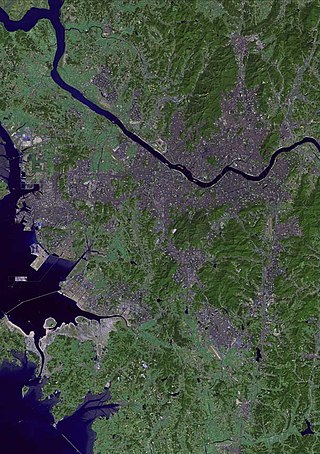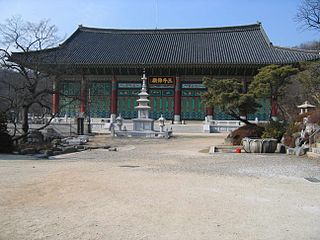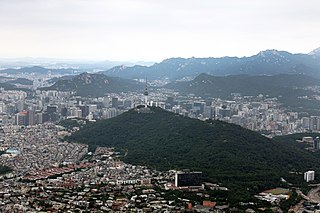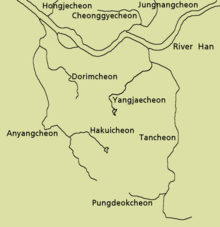
The Han River or Hangang is a major river in South Korea, with some of its tributaries and drainage basin in North Korea. It is the fourth longest river on the Korean peninsula after the Yalu ("Amnok"), Tumen ("Tuman"), and Nakdong rivers. The river begins as two smaller rivers in the eastern mountains of the Korean peninsula, which then converge near Seoul.

Uiwang is a city in Gyeonggi Province, South Korea. It is one of many satellite cities that ring Seoul, making up the Seoul Capital Area. Its largest immediate urban neighbor is Anyang. The low peaks of the Gwangju Mountains shape the local landscape.

Bongwonsa is a South Korean Buddhist temple in Bongwon-dong, Seodaemun District, Seoul, South Korea.

Namsan, officially Namsan Mountain, is a 270-meter (890 ft)-high peak in Jung-gu, Seoul, South Korea. It was also known as Mongmyeoksan, or 목멱산 / 木覓山 in the past. It offers some hiking, picnic areas and views of downtown Seoul's skyline. The N Seoul Tower is located on top of Mt. Namsan.

Jonggak Station is a station on the Line 1 of the Seoul Subway in South Korea. It is located on Jongno, central Seoul and comprises a large underground arcade.

Naejangsan is a mountain located on the border of North Jeolla and South Jeolla provinces in southwestern South Korea, approximately three hours drive south of Seoul. It has an elevation of 763 m (2,503 ft).

Yeouido is a large island on the Han River in Seoul, South Korea. It is Seoul's main finance and investment banking district. It is 8.4 square kilometres (3.2 sq mi) large and has a population of 32,674 as of August 2023.

Guro District (Guro-gu) is a district of Seoul, South Korea, which was separated from Yeongdeungpo District on April 1, 1980. Located in the southwestern part of the city, where besides Yangcheon District and Geumcheon District Guro District has an important position as a transport link which contains railroads, land routes from the rest of Seoul to the south of the country. The Gyeongbu and Gyeongin railway lines connect Seoul to Busan and Incheon. In addition, Seoul Metropolitan Subway lines 1, 2, and 7, and major highways intersect in Guro District.

Yeouinaru is a station on the Seoul Subway Line 5. Because of having to cross the Han River by a deep tunnel and not by a rail bridge, it is the deepest train station in South Korea with a depth of 27.5 metres (90 ft) below sea level.

Hapjeong Station is a subterranean station of Seoul Subway Line 2 and Seoul Subway Line 6. The station is located just north of the Han River in Mapo-gu. The name of the subway station comes from its local name. The name of the area means clam well.

Yeongdeungpo station is a ground-level railway station in Seoul, South Korea. The station is located in Yeongdeungpo Dong, Yeongdeungpo-gu, and is a stop on the Gyeongbu Line, Honam Line and Seoul Subway Line 1. The station is integrated into the Yeongdeungpo Lotte Department Store. Located in the station are Lotteria, Dunkin' Donuts, Krispy Kreme, and KFC.

Guro Station (Korean: 구로역) is a subway station in Guro District in Seoul, South Korea. It serves Seoul Subway Line 1.

Daerim Station (Korean: 대림역) is a station on the Seoul Subway Line 2 and Line 7. The station is located just south of the Han River in Yeongdeungpo-gu. The Line 2 station is elevated, while the Line 7 station is underground.

Gojan Station is a commuter train station on Seoul Subway Line 4 and the Suin–Bundang Line in Ansan, Korea. It is the closest station to Ansan Wa~ Stadium. Its station subname is Korea Univ. Ansan Hospital, as it is located nearby the station. The word "Gojan" originated as "inside of cape".

Seoul City Hall is a governmental building for the Seoul Metropolitan Government in South Korea, in charge of the administrative affairs of Seoul. It is located in Taepyeongno, Jung-gu, at the heart of Seoul. It is connected to City Hall Station (Seoul) on Seoul Subway Line 1, with access to Seoul Subway Line 2 from the same station. In front of the current city hall is the old city hall building, now Seoul Metropolitan Library, and Seoul Plaza.

Noryangjin Fisheries Wholesale Market or shortly Noryangjin Fish Market is an extensive farmers fish market in the neighborhood of Noryangjin-dong in Dongjak-gu, Seoul, South Korea. It is located east of 63 Building, and just south of the Han River. Metro line One passes through at Noryangin station near-by. Exit the station at exit 1 and walk under the bridge.
Bakdalsan is a mountain in the county of Goesan, Chungcheongbuk-do in South Korea. It has an elevation of 825 m (2,707 ft).

The Anyangcheon is a river in Gyeonggi-do and Seoul, South Korea. It has its source on the slopes of Mount Gwanggyo in the city of Uiwang and flows north, through the city of Gunpo, where a major cleanup operation saw several species of birds return to the area in 2005. Here, though, the water table remains depleted. The river then flows through Anyang City, where it is met by its major tributary, the Hakuicheon stream. From here, it loops around to the west before continuing north to the border with Gwangmyeong City. As the river passes to the west of Mount Gwanak, it forms the border between Gwangmyeong and Seoul, where it is lined on the Gwangmyeong side with rape fields and cherry blossom trees. After the stream is joined near Guil Station from the west by the Mokgamcheon stream, which forms another border between Gwangmyeong and Seoul, it is then totally within the capital. Here, it is also joined from the east by the Dorimcheon and passes through a conservation zone for migratory birds which was established after a 2005 cleanup operation, whereafter it joins the Han. Most of the length of the river has a path alongside providing easy access, the only parts without this lying in Uiwang. Seoul City Council has embarked on a programme of exclusive cycle path creation alongside its waterways, including the Anyangcheon, to be completed in 2010.
The climate of Seoul features a humid continental climate with dry winter, called "Dwa" in the Köppen climate classification, with four highly distinct seasons. In summer the influence of the North Pacific high-pressure system brings hot, humid weather with temperatures soaring as high as 35 °C (95 °F) on occasion. In winter the city is topographically influenced by expanding Siberian High-pressure zones and prevailing west winds, temperatures dropping almost as low as -20 °C (-4 °F) in severe cold waves. The bitterly cold days are commonly known to come in three-day cycles regulated by rising and falling pressure systems. The most pleasant seasons for most people in the city are spring and autumn, when azure skies and comfortable temperatures are typical. Most of Seoul's precipitation falls in the summer monsoon period between June and September, as a part of East Asian monsoon season.

Yongwangsan is a mountain in Seoul Yangcheon District Mok-dong, South Korea. Its height is 78 metres (256 ft), and it is also called Umji Mountain.





















